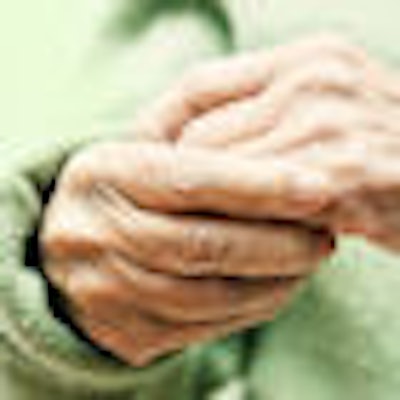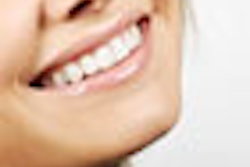
Think carbamide peroxide (CP), and the first image that comes to mind are shiny, white teeth.
But a new study has found that, in addition to being an effective bleaching agent, CP can be used to effectively suppress oral bacteria in patients with special care needs (Journal of the American Dental Association, June 2010, Vol. 141:6, pp. 639-646).
Special needs patients can pose great challenges for dentists because they are unable to maintain acceptable levels of oral hygiene, are susceptible to plaque accumulation, and are at increased risk for oral disease because of xerostomia, medication side effects, or a compromised immune system. Tray-applied 10% CP may hold great promise for improving the oral health of many of these patients, including the elderly, those with cancer, and those with dry mouth, according to the study authors.
"To our knowledge, this is the first comprehensive review of the alternative use of 10% CP," said lead author David A. Lazarchik, D.M.D., an associate professor at the College of Dental Medicine, Western University of Health Sciences in a DrBicuspid.com interview. "It must be emphasized that we are not suggesting replacing standard oral hygiene protocols (such as brushing and flossing), but rather supplementing them with CP use in patients who have difficulty complying with such protocols."
“We are not suggesting replacing standard oral hygiene protocols.”
— David A. Lazarchik, D.M.D.
Dr. Lazarchik and his colleague reviewed the antibacterial properties of CP; the effects of CP on saliva, plaque, caries, and gingival health; tray fabrication options and techniques; application methods; safety; side effects; and the challenges involved in using tray-applied CP materials. They found that CP's effects on plaque, gingival health, and caries generally have been overlooked in recent clinical practice, even though studies document the benefits of peroxide-based preparations for oral health.
Plaque suppression and caries control is a result of a CP-induced increase in salivary and plaque pH and possible antimicrobial action via physical debridement and the direct chemical effect of hydrogen peroxide, the authors noted. The net result is a potential improvement in gingival health and reduction in caries activity.
"It was surprising to find that there were many articles documenting the antibacterial properties of CP and effects, such as raising salivary pH, but few related to suppression of plaque and resultant effects on periodontal disease and caries," Dr. Lazarchik said.
It is important to note the difference between CP-based bleaching agents and those based on hydrogen peroxide (HP), he added. "Bleaching agents that contain HP but not CP do not raise salivary pH since they do not release urea as CP does. Thus, HP-based agents would not necessarily have the same caries suppression properties as CP-based agents."
Tray-applied advantages
Using tray-applied CP can be an effective way to improve oral health for special needs patients because it does not require much manual dexterity, the authors wrote.
"The methods of use documented in the study are especially pertinent to certain groups of special care patients who can cooperate for fabrication and use of applicator trays, but who might otherwise have difficulty maintaining adequate oral hygiene by traditional methods alone," Dr. Lazarchik said.
The same nonscalloped, nonreservoir tray design used in this method is commonly used for bleaching trays, which would be quite familiar to dentists, he noted.
Patients who can benefit most from this method are those with impaired manual or mental dexterity, such as severely arthritic patients, stroke and Parkinson's disease patients, and Alzheimer's disease patients, or those with impaired host defenses, such as patients with xerostomia, according to Dr. Lazarchik.
This method may also be beneficial for other types of patients at high risk for caries, such as those with a high sugar intake, extensive restorative dentistry, or poor compliance with commonly recommended oral hygiene protocols.
Some potential problems associated with this method are that it may not be applicable to those special care patients who cannot tolerate impressions or thermoplastic trays required for applicator tray fabrication or who cannot cooperate enough to allow tray use, Dr. Lazarchik explained.
Other possible issues include tooth sensitivity, increased calculus formation, color difference between teeth and restorations, and expense.
These concerns notwithstanding, the method may come as a welcome relief to dentists who are dealing with the challenge of special care patients, Dr. Lazarchik said.
"Great efforts can be made on the part of the dentist to restore a mouth to health, with significant expense to the patient, only to see restorative success undermined by poor compliance with oral hygiene regimens," he said. "For some patients, the use of CP as described in our article may serve as a supplement to standard oral hygiene protocols, reducing subsequent restorative failure and the need for retreatment."
More research needed
More research is needed to prove conclusively that this method is effective in the special care population and to facilitate the development of cost-effective products for daily use, the study authors concluded.
James Summitt, D.D.S., M.S., professor and chair of the department of restorative dentistry at the University of Texas Health Science Center at San Antonio, told DrBicuspid.com that the article was timely and well done.
He and his colleagues presented a study (partially funded by Ultradent) at the 2005 International Association for Dental Research meeting that evaluated and compared the effect of carbamide peroxide on the bacteria in fissure lesions (noncavitated). They found that 10% carbamide peroxide gel was bacteriocidal within fissure caries lesions and penetrated the fissure and carious tooth structure to kill bacteria.
"Carbamide peroxide is antibacterial and, as the authors point out, has the potential to interrupt caries activity by increasing the oral pH," Dr. Summitt said. "It is reasonable that, in special care patients with high levels of plaque bacteria, it will effect reduction in oral disease."
He agreed with the authors of the JADA study that the clinical evidence to support this effect is weak, however, and that well-done clinical studies on the topic are needed on.
Editor's note: One of the study authors, Van Haywood, D.M.D., has or has had affiliations with the following companies mentioned in the JADA article: Archtek, GlaxoSmithKline, and Ultradent Products.
Copyright © 2010 DrBicuspid.com



















